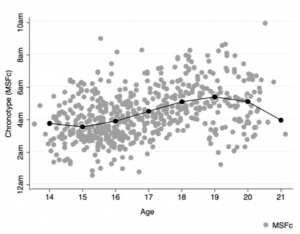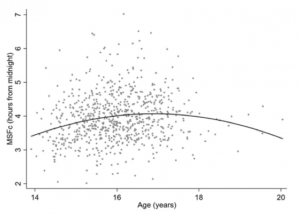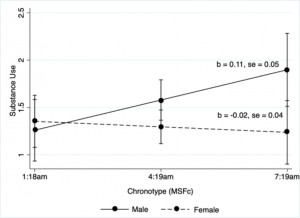Chronotype refers to individual differences in the propensity for early or late bed and wake times, partly determined by the body’s circadian rhythm. Morning chronotypes go to bed and wake up early while evening chronotypes go to bed and wake up late. Adolescents experience a delay in chronotype toward eveningness and this is distinct from morningness which is prominent among children and adults.
Measured using sleep bed and wake time information, an evening chronotype has been linked with poorer behavioral and health outcomes among adolescents. Research from our lab has examined developmental trends in chronotype and found associations between chronotype and adolescent externalizing behaviors.
Developmental Changes in Chronotype

Research from our lab recently published by the Journal of Youth and Adolescence examined developmental age trajectories of chronotype among a sample of ethnically diverse adolescents. We measured chronotype with the mid-sleep point between bed and wake times the night before “free,” or unscheduled days (MSFc). We found that chronotype delayed toward eveningness from 14 to 19 years followed by a return toward morningness after age 19.

Interestingly, in another paper from our lab published by the Development and Psychopathology, analyses highlighted 16.9 years of age as the transitionary age at which eveningness reverts to morningness among adolescents, however, this research was based on a Mexican-American adolescent sample further necessitating work to examine potential differences in chronotype by race or ethnicity. This same study found that adolescent and parent chronotype were contemporaneously correlated suggesting a potential role of family context in shaping adolescent sleep patterns.
Later chronotype appears to peak around late adolescence
Risky Behavior and Substance Use

We also have examined associations between adolescent chronotype substance use and risky behavior. Findings within the ethnically diverse sample demonstrated that an evening chronotype is associated with more risky behaviors and substance use among males, and more substance use among older adolescents. Substance use was also positively associated with an evening chronotype among all adolescents in the Mexican-American sample.
A particularly late chronotype is associated with more risky behaviors and substance use
Conclusion
Taken together, the significant non-linear age trends highlight adolescence as a key period of developmental change in bed and wake times according to the body’s circadian rhythm. Links between an evening chronotype and greater externalizing behaviors among youth point to sleep timings as a potential focus for intervention efforts aimed at reducing harmful risk-taking and substance use.

